Matador Network's Blog, page 1031
August 20, 2019
Signs need to go back to bartending

You can take the bartender out of the bar, but you can’t take bar life out of a former barkeep. Some former bar staff move on to new careers and industries, but, after a break, some need to come home again. From missing the camaraderie to hating your early morning alarm, here are seven signs you need to return to bartending.
1. At the company happy hour, you’d rather be behind the bar serving your co-workers than making small talk with them.
Awkward small talk is a part of most work environments, but as a bartender, you can always escape the small talk by feigning busy work. As an office worker trapped at an employee happy hour, you’ve got to fake a phone call to get out of there. If, as a former barkeep, you find yourself staring wistfully at the liquor bottles as your boss drones on about quarterly projections, maybe it’s time to get back behind the stick.
2. You assault your cell phone every time your morning alarm goes off.
Mornings are rough on most, but when you have spent your working life adapting to evening work hours, mornings are even rougher. If it has been years of fighting with your alarm and you still haven’t adapted to the nine-to-five, maybe that’s your sign.
3. You say things like “I used to be a bartender” to any waitstaff you encounter.
Former bartenders love reminiscing to current bar staff about how they used to work in a bar. If it seems like no one makes a Manhattan like you used to, you can’t believe what passes for good service these days, or you feel the need to befriend every bartender you meet, maybe you must accept that you can’t quit the bar game.
4. You miss the feeling of camaraderie at work.
There are few industries where you connect with your co-workers in the same way as the service industry. At times, it can feel like high school, but you form deep friendships from working in the trenches together. It is a very special dynamic that is hard to replicate in the white-collar world.
5. You get nostalgic for the family meal.
The family meal, the pre-shift moment when staff all gather round to share some food, is a cornerstone of many hospitality jobs. It is a moment to check-in, to gossip, to bond with the back of house, and to complain. Often, even at great restaurants, the family meal is barely edible — it’s the chicken that is about to go bad, it’s the pancakes from brunch that didn’t sell, it’s the dry pasta that costs a nickel a pound. So, if you’re waxing nostalgic about family meals of yore, you’re in need of a reminder to bring you back to reality.
6. You can’t wait to tell someone “no” to a request.
In the service industry, it is your job to accommodate customer requests when possible. Even though pleasing people can be rewarding, it takes a toll. There is nothing more satisfying after a day of “yes” than saying “no.” Do you have Casamigos? No. Is your kitchen still open? No. Can I get a rum and coke (even though I am visibly wasted)? Hell no.
7. Bartending has become your “good ol’ days.”
Nostalgia for our youth is part and parcel of aging, but if bartending were the best days of your life, maybe it’s a sign that working in bars is the place for you. 

More like this: 7 ways a bartender can tell you’re a rookie drinker
The post 7 signs you need to return to bartending appeared first on Matador Network.

August 19, 2019
Winter in Japan: 2 perfect trips
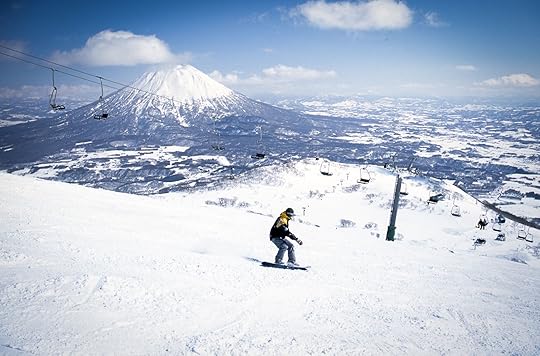
Winter in Japan: 2 perfect trips
By: Selena Hoy
Photo: Japan National Tourism Organization
Japan is marked by a series of handsome mountain chains — you can thank the country’s position on the edge of several colliding tectonic plates for that. And on many of these mountains, winter brings some of the finest powder in the world. So fine, in fact, that powderhounds from across the globe make the trek to ski and snowboard here. Among the many options, two destinations stand out: the northern island of Hokkaido, and the mainland’s prefecture of Nagano.
But it’s not just the snow that gives these places their legendary winter status. You’ll also find natural geothermal springs, fresh local cuisine, and bucolic nature to keep you busy on and off the slopes. Both Hokkaido and Nagano offer so many choices when it comes to wintry playgrounds, it might be hard to choose one over the other. Our advice: choose both.
Get to Hokkaido and Nagano from Tokyo via All Nippon Airways and Japan Railway, respectively.


This guide is proudly produced in partnership with the Japan National Tourism Organization.
Inspire your trip
x
Ski + Snowboard
Niseko, Hokkaido
Hakuba, Nagano
Hokkaido is the northernmost of Japan’s primary islands, as well as the coldest — there’s snow on the ground about six months out of the year. This means plentiful ski resorts and even more plentiful backcountry options.
Down on the main island of Honshu, Nagano is a landlocked prefecture with a spine of 9,000-foot mountains, including the Northern, Central, and Southern Japanese Alps. It’s sometimes called the “Roof of Japan,” with nine of the 12 highest mountains in the country found here — and with that, snow and alpine air are in abundance.
Hokkaido
When you’re looking for consistent deep, dry powder, Niseko is always a safe bet. Located 55 miles southwest of Sapporo in a quasi-national park, the resort zone is centered around Mt. Niseko Annupuri, standing 4,292 feet tall. With a season that runs from late November through April, the Niseko area gets upwards of 50 feet of snowfall per year, fed by coastal moisture and very cold temperatures.
Four resorts work together under the name Niseko United to create interconnected runs over some 2,200 skiable acres, and there are plenty of easily accessible side and backcountry runs for those who want first tracks. Be sure to choose a reputable guide company with avalanche certification; snowmobiling, CAT skiing, and snowshoe tours are just a few of the other off-piste options.
Nagano
With 30+ feet of snow every year, both Nozawa Onsen in northern Nagano and Hakuba Valley in northwestern Nagano are reliable destinations for snow fans looking for some downhill action just a hop and a skip from the metropolis. The area is known for fine weather, so skiers and boarders can enjoy bluebird alpine views before plunging into the powder.
Hakuba Valley, site of the 1998 Winter Olympics, has a variety of terrain that makes it suitable for families and thrill-seekers alike. Ten resorts participate in a common ticket, making it easy to jump from one area to another. Nozawa Onsen combines the ambiance of a traditional hot spring town with excellent runs and over 3,200 feet of vertical. Get off the groomed trails with a backcountry operator, or even try heli-skiing for some truly fresh tracks.
Photo credits: Japan National Tourism Organization
Onsen (hot springs)
Noboribetsu, Hokkaido
Nozawa Onsen, Nagano
Whether its muscle aches from a day of action, taking the chill off from the freezing temperatures, or just a treat for yourself, dipping into the local onsen, or hot springs, is a relaxing balm for the bustle of daily life and an excellent way to get a taste of Japanese culture. And the onsen of both Hokkaido and Nagano are hard to beat.
Hokkaido
Onsen are usually connected to lodgings, especially ryokan (Japanese-style inns). Public baths are also available, including some mixed-gender baths where swimsuits are allowed, for those too shy to go nude in traditional onsen. Rotenburo, or open-air baths, let you be at one with nature under the stars, the cold snap of the air neutralized by the mineral steam. All of these and more can be found in Hokkaido.
In Niseko, the public Makkari Onsen has tremendous mountain views. Further afield, the hot spring town of Noboribetsu, on the coast south of Sapporo, is perhaps Hokkaido’s most famous onsen location, set within Shikotsu-Toya National Park. It’s a worthy day trip, with active volcanoes and caldera lakes to explore before sinking into the springs.
Nagano
Ample hot springs in both Nozawa Onsen and Hakuba offer end-of-day rewards for aching muscles. Whether it’s in a refined hotel in Hakuba or the free public hot springs of Nozawa town, there’s a nearby pool to ward off the chill.
Nozawa Onsen has around 30 hot springs, including 13 public baths called soto yu. The adventurous can clop along the streets in wooden clogs, wrapped in yukata (thin kimonos), visiting each in turn. There’s no charge, but honor boxes posted at each bath are there for a few coins’ donation. Meanwhile, at the Hakuba Highland Hotel’s Tenjin no Yu, even non-guests can pay a few hundred yen to access the million-dollar sweeping views of the Northern Alps from the open-air springs.
Photo credits: Japan National Tourism Organization and Shutterstock/Poh Smith
Food + Drink
Otaru sushi, Hokkaido
Oyaki dumplings, Nagano
Forget everything you know about Japanese food. As with any country’s cuisine, once you’re there, you’ll discover the complexities and regional specialties that nobody back home has heard of. And you’re in luck, because your winter trip has brought to places where eating and drinking are very memorable experiences.
Hokkaido
Hokkaido is well-known in Japan and beyond for its superlative seafood, caught in the deep, cold oceans fed by the plankton-rich Oyashio Current bordering the island. Crab varieties like snow and king are a specialty (Niseko’s Crab Dining Kanon features three types), as are scallops, fat salmon, and octopus. Try them all together in a kaisen don, or rice bowl, topped with a variety of seafood.
Sea urchin should only ever be eaten fresh, and in Hokkaido, urchin is buttery and sweet, often served as sashimi. Seafood enthusiasts can make a trip to Hakodate’s famous morning market, where 250 vendors hawk freshly caught mackerel, squid, salmon roe, and much more; pull up a plastic chair and get a super-fresh version of the seafood rice bowl here. Heartier regional fare includes salmon hotpot, stewed with vegetables and tofu, and “Genghis Khan” barbecue, featuring grilled mutton and mixed vegetables.
Nagano
All that exertion at elevation works up an appetite. You may think you’ve tried soba (buckwheat) noodles and wasabi back home, but chances are they tasted nothing like they do in Nagano, where soba is grown locally and freshly made noodles are cut daily. And while most tube wasabi is blended with horseradish and food coloring, you’ll get the real thing here, ground moments before eating from the wasabi rhizome — sweet and delicately spicy.
Nagano is also known for wild mountain vegetables and apples, and the cold mountain air and sweet clear water provide the perfect conditions for the dozens of sake breweries around the prefecture that churn out fine local nihonshu (sake) to accompany the fresh mountain fare. Some are even open to tours, though advance booking may be required.
Photo credits: Japan National Tourism Organization
Nightlife
Sapporo Beer Museum, Hokkaido
Nightlife in Nagano
From hidden aprés-ski hotspots to entertainment districts second only to Tokyo, the day is only warming up when the sun falls beneath the mountains. And with the right whisky, you’re only warming up, too. Here’s your guide to winter nightlife in these two destinations.
Hokkaido
Wash it all down with one of Hokkaido’s native tipples, such as Sapporo beer, Nikka whisky, or sake from one of the island’s many breweries. Niseko has plenty of wine bars and izakaya (Japanese dining bars), especially in the Hirafu area. Try Toshiro’s Bar for a huge selection of whisky, including many hard-to-find Japanese varieties, or Tamashii for a more classic izakaya experience.
For a big-city buzz, head to Sapporo’s entertainment district, Susukino, which teems with pubs, karaoke bars, and clubs. Check out Bar Yamazaki, a low-key, old-fashioned joint where the bartenders have been plying their trade for half a century, or Bar Orb, a small, friendly LGBT bar with beer, cocktails, and a few snacks.
Nagano
Hakuba’s nightlife runs more sophisticated and international, while in Nozawa, local charm and cultural offerings rule. Tracks Bar in Hakuba Goryu has live music and DJs, while Mocking Bird serves up beer and curry in a rustic, hippie setting.
In Nozawa Onsen, Himatsuri Restaurant and Bar in Ryokan Jonnobi is a sleek, elegant dining-and-drinking experience with refined cuisine like sashimi and tempura served with locally made sake. Beer lovers can head to The Craft Room for craft brews and nibbles.
Photo credits: Japan National Tourism Organization and Johnny Greig.
Nature
Kushiro Shitsugen, Hokkaido
Snow Monkey Park, Nagano
The popular conception of Japan probably centers on a bustling Tokyo street scene, but this belies the fact that the country is dotted with nature preserves packed with wildlife. Hokkaido’s Kushiro Shitsugen National Park alone has over 2,000 types of animals, including Japan’s national icon, the Tancho crane. And in Nagano? You’ll be chilling with the snow monkeys.
Hokkaido
To take a break from snow play, head to the east coast of Hokkaido to Kushiro Shitsugen National Park, 100+ square miles of wetlands teeming with wildlife.
The red-crowned crane, or tanchozuru in Japanese, is an important symbol of the country, so much so that it was printed on the old 1,000 yen note. Representing luck and longevity, these usually migratory birds live year-round in the marshes of Kushiro Shitsugen. Winter is their mating season, and their graceful mating dance, red-headed and long-legged, is a sight to behold.
Nagano
Just like humans, the Japanese macaques of Jigokudani (literally “Hell Valley,” named for its sulfurous steam amid steep, craggy cliffs) in northern Nagano love to warm up by taking a soothing soak in the natural hot springs of the so-called Snow Monkey Park.
These wild snow monkeys don’t seem to mind the tourists that come to watch whole families bathing together in the chilly highlands — just don’t try to get in with them. The macaques’ distinctive red, human-like faces peeking out of tan fur only seem to get redder when they’re immersed in the hot water.
Photo credits: Japan National Tourism Organization, Shutterstock/Sean Pavone, and Shutterstock/Littlewormy
Get to Hokkaido and Nagano from Tokyo via All Nippon Airways and Japan Railway, respectively.

This guide is proudly produced in partnership with the Japan National Tourism Organization.
The post Winter in Japan: 2 perfect trips appeared first on Matador Network.

Where to see grunge music in Seattle
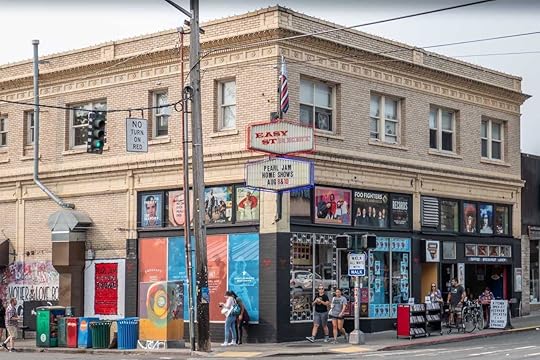
The less than flattering term “grunge” dates back to at least 1981, when a young high school student named Mark McLaughlin was describing his band, Mr. Epp and the Calculations, in the now-defunct Desperate Times magazine. The man who would later replace his surname McLaughlin with the edgier Arm referred to his band as “pure grunge, pure noise, pure shit.” Six years later, Sub Pop Records co-founder Bruce Pavitt would describe Arm’s band, which included two future members of Pearl Jam, Green River’s “Dry as a Bone” EP as “ultra-loose grunge that destroyed the morals of a generation.” That same year, Sub Pop would release Soundgarden’s raw debut EP, “Screaming Life”. By the time they released Nirvana’s debut album, “Bleach,” in 1989, Soundgarden was signed to A&M, and the major labels had figured out that there was something going on in Seattle besides Starbucks and rainy days. In a nutshell, this is how grunge as we know it came to take over Seattle.
Many boast the “grunge is dead” mantra loudly, but you can still see many of the spots that put these bands on the map around town. This is a list of places that grunge fans can still visit around town, arranged in chronological order as much as possible. Included are obvious places like MoPOP and the former Cobain residence, but you can also visit the hotels, parks, record stores, concert venues, and more that require the type of deep digging that Eddie Vedder accused the music industry of failing to do in the 1996 film, “Hype!”
The rise and fall of an iconic Seattle sound
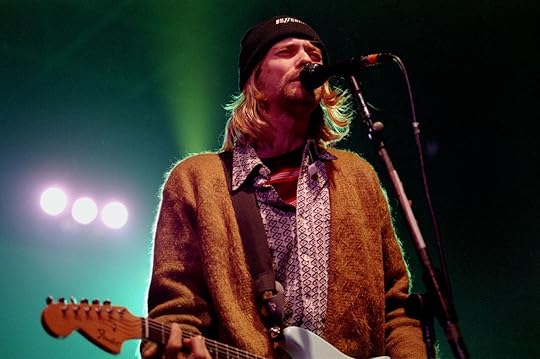
Photo: Fabio Diena/Shutterstock
By August of 1991, all four of the grunge bands most commonly referred to as the “big four” were signed to major labels. Nirvana signed to Geffen while Alice in Chains and Pearl Jam released their debut albums on Columbia and Epic. None of those bands were fond of the word grunge, though there was a general camaraderie among the members, save for Kurt Cobain’s verbal attacks on Pearl Jam.
In January of 1992, Nirvana’s “Nevermind” knocked Michael Jackson from the number one spot on the Billboard 200. The big four would release a combined six more number one albums by 1996. By the following year, Pearl Jam was the only band still going, and to this day, they remain the only of the original big four still relatively intact — with four of the five original members. The scene fell from the mainstream as fast as it rose, due in large part to the 1994 suicide of Kurt Cobain followed by Layne Staley’s heroin-fueled hiatus, which started in 1996, and Soundgarden’s 14-year hiatius, which began the following year. Seattle has moved on, but for many music fans, Seattle history starts with the founding of Sub Pop and ends with “Down on the Upside.” Despite how locals may feel about the overexposure of a handful of bands that brought the “Seattle sound” to the mainstream, the city has done an amazing job of preserving this history for fans.
1. Terminal Sales Building

Photo: Brian Cicioni
In early April of 1988, the label that introduced the world to Mudhoney, Nirvana, and Soundgarden moved into its 11th-floor office in Seattle’s Terminal Sales Building. That same year, Sub Pop co-founder Bruce Pavitt assured Chris Cornell, “Seattle’s gonna take over the world.” Sub Pop has gone on to outlive Nirvana, Soundgarden, and even its founders, with the “Going Out of Business Since 1988” motto remaining to this day. Back then, most (including one of the frontmen who would help make that happen just four years later) would have brushed him off as overly ambitious. To this day, the elevator only goes up to the 10th floor of the Terminal Sales Building. You have to walk up from there. The current “world headquarters” is just four blocks from the Terminal Sales Building.
Where: 1932 1st Ave.
Nearest light rail station: Westlake
2. A Sound Garden
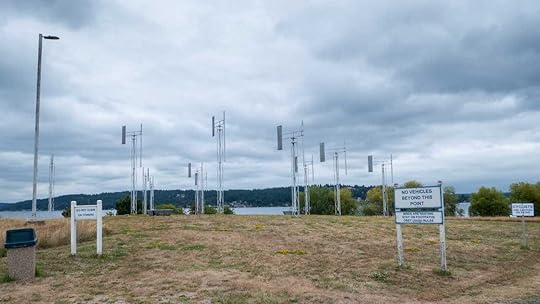
Photo: Brian Cicioni
The first of the Seattle grunge bands to sign to a major label, Soundgarden took its name from this outdoor public artwork located on the National Oceanic and Atmospheric Administration (NOAA) campus. The sculptural group of a dozen 21-foot high steel towers makes un-grunge-like soothing sounds when the wind passes through. This is because each one is topped with an organ pipe attached to a weather vane. Bring your imagination and visit during a windy day, and maybe you’ll hear the intro to “The Day I Tried to Live” or “Beyond the Wheel.” Either way, the setting along the northwest shore of Lake Washington can be a serene escape from gridlock traffic and the seemingly never-ending luxury condos that seem to be sprouting up everywhere near the downtown area.
Where: 7600 Sand Point Way
3. Central Saloon
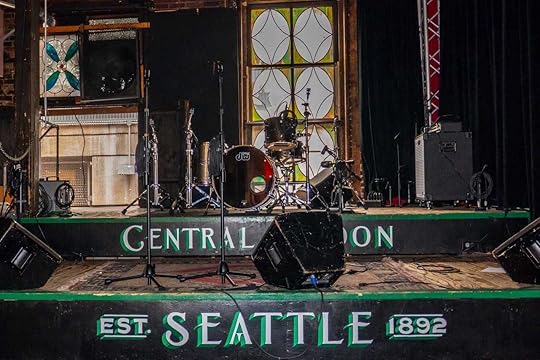
Photo: Brian Cicioni
One of the last grand old saloons, The Central dates back to the 1890s, opened just three years after the great fire. Before Alice in Chains, Nirvana, and Soundgarden headlined arenas and festivals around the world, they all played at the Central. The venue is similar in size to the former CBGB and still hosts bands. The walls are lined with photos and concert flyers from the days, which led up to the brief period when Seattle seemed like the center of the musical universe.
Where: 207 1st Ave South
Nearest light rail station: Pioneer Square
4. El Corazon (the former Off Ramp Cafe)

Photo: Brian Cicioni
On October 22, 1990, Mookie Blaylock played its first show at the Off Ramp Cafe. The following year, the band opened for Alice in Chains on its “Facelift” tour, signed a deal with Epic Records, renamed itself Pearl Jam, and released its debut album, “Ten,” in honor of Blaylock’s basketball jersey. The building is still there, but it’s been renamed El Corazon. If you search for it on Google Maps and find Funhouse, it’s the same building.
Where: 109 Eastlake Ave.
Nearest light rail station: Westlake
5. Re-bar
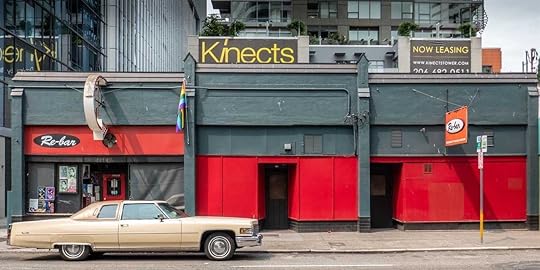
Photo: Brian Cicioni
Re-bar opened in 1990, just as Seattle bands like Nirvana and Soundgarden were gaining national recognition. Steve and Linda meet here in the movie “Singles.” On September 13, 1991, Friday the 13th, Re-bar hosted the release party for Nirvana’s second studio album and major label debut, “Nevermind.” After the band members started an alcohol-infused food fight, they were kicked out of their own record release party. “Nevermind” would go on to sell more than 10 million copies in the US and 30 million worldwide. Courtesy of Jeff Ament, you can now see a replica of the Mother Love Bone mural (featured in Singles) on the wall outside Easy Street Records in West Seattle. Despite all the post-2000 changes in Seattle, the venue is still going strong today.
Where: 1114 Howell St.
Nearest light rail station: Westlake
6. The Paramount
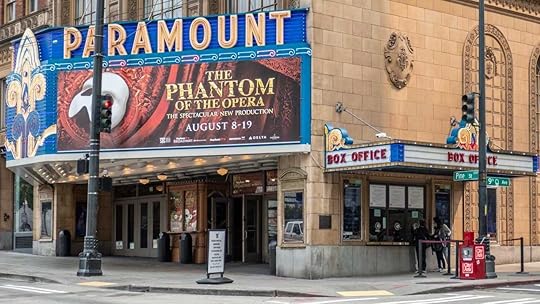
Photo: Brian Cicioni
The Paramount has been on the National Register of Historic Places since 1974, in part because local bands like Heart, Nirvana, and Soundgarden recorded concert films at the venue. Nirvana played here on Halloween 1991, just five weeks after the release of “Nevermind.” They opened with an electric version of The Vaselines “Jesus Doesn’t Want Me For a Sunbeam” and also played the then-unreleased “Rape Me.” The show was officially released 20 years later as “Live at the Paramount.” Soundgarden’s March 6, 1992, Paramount show was released in its entirety under the same name as part of the 25th-anniversary re-release of “Badmotorfinger.”
Where: 911 Pine St.
Nearest light rail station: Westlake
7. The West Point Lighthouse
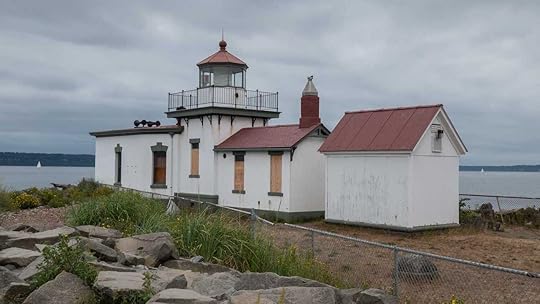
Photo: Brian Cicioni
This is the lighthouse you see in Temple of the Dog’s “Hunger Strike” video. Just months before Chris Cornell broke his Rusty Cage, and Eddie Vedder let the world know that he’s still alive, Temple of the Dog released its only album. It started as a tribute to Mother Love Bone (Jeff Ament and Stone Gossard’s pre-Pearl Jam band) frontman, Andrew Wood. The project started with two songs, “Say Hello 2 Heaven” and “Reach Down,” and eventually was released as an album featuring Chris Cornell and the Pearl Jam lineup from 1998 to the present. Both the lighthouse and the beach they perform on are part of Discovery Park, which is situated on the Puget Sound.
Where: 3801 Discovery Park Blvd.
8. The Former Cobain Residence

Photo: Brian Cicioni
The house Kurt Cobain spent his final days in is located along Lake Washington Blvd. in an exclusive neighborhood, just one block west of the lake. The house is hidden behind several tall trees. A tall wooden gate prevents entry to the property. Fans still get their pictures taken in front of the gate, although the house has not been in the Cobain family since at least 2003.
Where: 171 Lake Washington Blvd. East
9. Viretta Park

Photo: Brian Cicioni
Located next to the house that Kurt Cobain spent his final days in, Viretta Park has multiple benches covered with Nirvana-related graffiti. It’s a somber setting in an upscale neighborhood along Lake Washington. Fans leave gifts ranging from commonplace offerings like cigarettes and books to more eccentric items like bootleg CDs, booze, and other groceries.
Where: 151 Lake Washington Blvd. East
10. The Moore Theatre
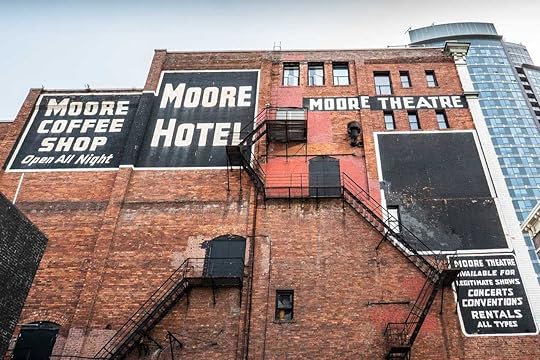
Photo: Brian Cicioni
Dating back to 1907, the Moore Theatre is the oldest Seattle theater still in use. Alice in Chains, Pearl Jam, and Soundgarden played there before they headlined arenas and stadiums. Some of the concert footage you see in Pearl Jam’s video for “Even Flow” was taken from a live performance at the Moore. Soundgarden recorded its 1988 “Fopp” EP here before signing with A&M. To see a healthier looking and more energetic Layne Staley, check out the Alice in Chains “Live Facelift” concert film from December 1990. Fewer than five years later, Mad Season (a Seattle supergroup fronted by Staley) recorded its only concert film, “Live at the Moore,” in the same venue. It proved to be their final show and Staley’s final performance in his home city. He died of an overdose in his University District condo fewer than seven years later.
Where: 1932 2nd Ave.
Nearest light rail station: Westlake
11. The Showbox
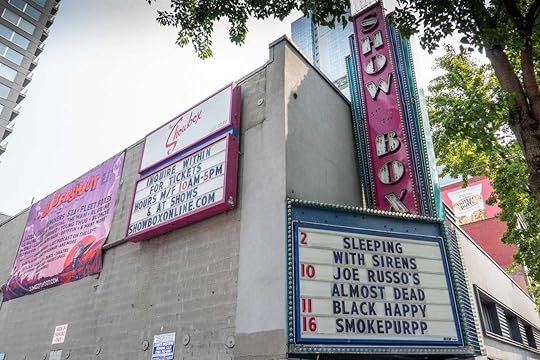
Photo: Brian Cicioni
The legendary Showbox dates back to 1939. Jazz legend Duke Ellington played here, as did blues guitarist Muddy Waters and The Ramones before their Seattle offsprings like Mudhoney, Pearl Jam, and Soundgarden made it a household name. In 2003, Pearl Jam released a limited edition DVD of its 2002 performance here called “Live at the Showbox.” The show is notable for the unveiling of the George W. Bush mask during “Bushleaguer,” as well as an Eddie Vedder anti-war improv at the end of “Daughter.” Both would make regular appearances during their 2003 world tour.
Where: 1426 1st Ave.
Nearest light rail station: University Street
12. Benaroya Hall
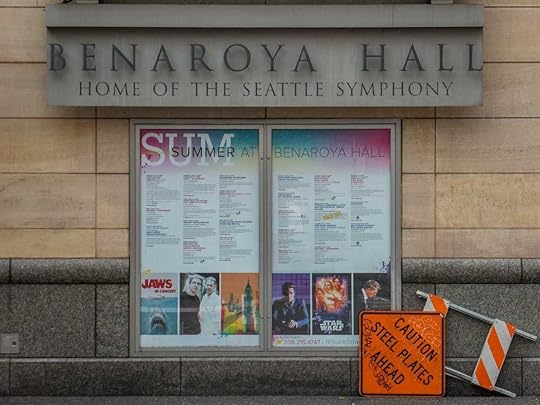
Photo: Brian Cicioni
Benaroya Hall is home to the Seattle Symphony. On October 22, 2003, Pearl Jam played a mostly acoustic show here to raise money for the Seattle-based charity YouthCare. It was released the following year on vinyl and as the two-CD set, “Live at Benaroya Hall.” The show marked the live debuts of “Man of the Hour,” the B-side “Fatal,” and a cover of Johnny Cash’s “25 Minutes to Go.”
Where: 200 University St.
Nearest light rail station: University Street
13. Screwdriver Bar

Photo: Brian Cicioni
This basement bar in Belltown served as Nirvana’s rehearsal space between “Bleach” and “Nevermind.” The three owners will proudly tell you that the last name on the lease before they took over was none other than Nirvana. Nowadays, the Screwdriver is a friendly neighborhood juke joint, which occasionally hosts live acts. The main barroom is like a rock and roll shrine of sorts. The walls are lined with images of rock icons from the 1960s to the present. They even have a Kiss pinball machine.
Where: 2320 1st. Ave
Nearest light rail station: Westlake
14. Easy Street Records

Photo: Brian Cicioni
Dating back to 1988, when CDs started to replace vinyl and cassette, Easy Street is an independent record store located in West Seattle. It also serves as a cafe and sometimes performance venue. This densely packed music store has hosted more than 500 in-store performances, and Pearl Jam released “Live at Easy Street,” an EP of their April 25, 2005, in-store performance.
Where: 4559 California Ave. Southwest
15. The Edgewater

Photo: Brian Cicioni
A innocent-looking picture of The Beatles fishing out of their second-floor room helped make The Edgewater the place to stay for visiting top acts in the latter half of the 1960s. Thanks to a July 1969 tale involving members of Led Zeppelin and Vanilla Fudge, a (naked) tied-up groupie, and a mud shark, the hotel along Elliot Bay is forever cemented in rock folklore. Only two bands have suites named in their honor at The Edgewater — one is The Beatles, and the other is Pearl Jam. Fifty years after the Edgewater became an iconic landmark for music fans and nearly 30 years after songs like “Jeremy,” “Even Flow,” and “Alive” were first heard around the world, Pearl Jam gets the same treatment in its home city as the most iconic rock band in world history.
If you can shell out at least $1,000 per night, you can stay in room 464 with your own guitar, Marshall amp, mini library, record player, and curated vinyl collection. As you enter the suite, you’ll see dozens of concert flyers from past Pearl Jam shows on your right. A replica of the famous Mother Love Bone mural hangs above the king-size bed while there are framed, hand-written setlists to the right. The bathroom wallpaper is an audience shot from an outdoor Pearl Jam show. Unlike the Beatles suite, the PJ suite has a balcony, offering panoramic views of Elliot Bay. Unfortunately, fishing from the balcony is no longer permitted.
Where: 2411 Alaskan Way
Nearest light rail station: Westlake
16. MoPOP (the former Experience Music Project)
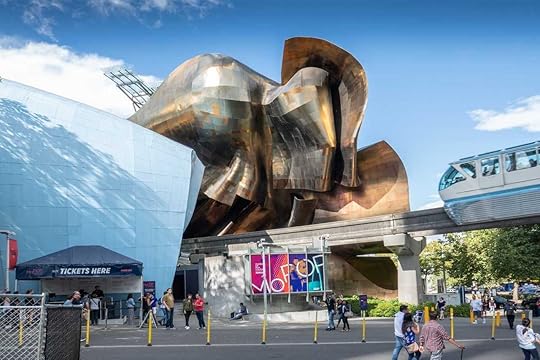
Photo: Brian Cicioni
In November 2016, the former Experience Music Project rebranded itself as the Museum of Pop Culture (MoPOP). The famous guitar sculpture is still there, and you can still play with an array of instruments on the second floor, but the 140,000-square-foot museum now focuses on film as well. The music exhibits still focus on artists from the Pacific Northwest. Current exhibits include “Nirvana: Taking Punk to the Masses” and “Pearl Jam Home and Away.”
The Nirvana exhibit is the smaller of the two and has interesting items like Kurt Cobain and Dale Crover’s first demo tape, as well as a map of where the “Seattle” bands actually came from. Tad is originally from Boise, Idaho! The exhibit also contains a typed-out setlist from Nirvana’s final show. The much larger Pearl Jam exhibit has enough band memorabilia to be a separate museum by itself. Most items are encased behind glass. They include Eddie Vedder’s George W. Bush mask from the 2003 tour, as well as Stone Gossard’s Devo costume from when Pearl Jam played the final show at the Philadelphia Spectrum on Halloween 2009.
Where: 325 5th Ave. North
Nearest light rail station: Seattle Center Monorail (connection from Westlake) 

More like this: This is the ultimate New York itinerary for Ramones fans
The post The ultimate grunge guide to Seattle appeared first on Matador Network.

Surfing tourism in Nicaragua
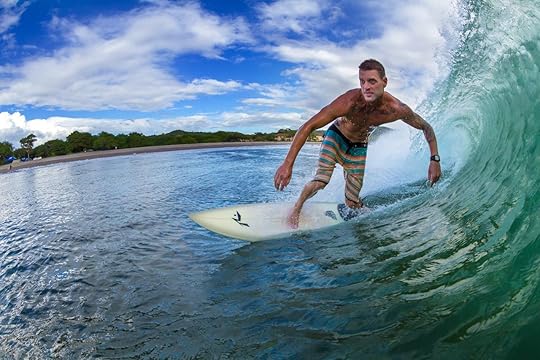
As I shuffled toward my seat in the back of the plane on a recent trip to Nicaragua, I was surprised by the faces that looked up at me as I passed. My earlier trip to the country in 2016 had been at the height of its tourism boom. During that time, a flight bound for Managua would have been comprised of a motley crew.
On board back then, you’d have seen resort travelers in straw hats ordering rum cocktails, grungy backpackers looking like they’d already been hiking for days, and maybe a dozen teenagers in a youth group planning to volunteer at a Nicaraguan mission. For sure, you’d see burley surfers from California or Florida, complete with wetsuit tan lines.
The point is, if you were flying to Nicaragua before the summer of 2018, you were part of a vast, varied group that contributed to the economic boom that put Nicaragua on the travel-industry map. However, in the summer of 2018, travel to Nicaragua came to a screeching halt.

Photo: Will Ulmos/Shutterstock
In April 2018, protests over Nicaraguan president Daniel Ortega’s cuts to social security broke out in the country’s urban areas. At first, the protests were small and consisted mainly of those who would be immediately impacted by the new policy. As Ortega’s government responded to protesters with unprecedented violence, demonstrations spread across the nation.
Eventually, the social security cuts were scrapped, but by that point, the country was outraged by the deaths of peaceful protesters and demanded early elections. For the next few months, a back and forth between protesters and the government ensued that left hundreds dead, many wounded, and thousands displaced. Alas, Ortega survived the turmoil and remains in power in Nicaragua.
Since then, life has slowly returned to its normal, peaceful state, but the political strife led many foreign governments to issue travel warnings. The US State Department labels Nicaragua under the Level 3 Travel Advisory, “reconsider travel,” even though there haven’t been incidents of violence since the summer of 2018.
While the protests, which were labeled a “failed coup attempt” were a shock to the world and devastating to the country, officials at the Nicaraguan Tourism Board pointed out that, statistically, traveler safety was unaffected. “There have been absolutely no issues or incidents with tourists and protesters or the police in [the] country,” an official there told me.
The Tourism Board directed me to a recent study on homicide published in July 2019 by the UN Office on Drugs and Crime, which shows that the homicide rate in Nicaragua is among the lowest in Central America. While El Salvador, Guatemala, and Honduras consistently rank highly for gang activity, violence, and crime, Nicaragua, Costa Rica, and Panama are grouped together in the lower risk category.
In fact, a deeper look at the US State Department website reveals that its Level 3 Travel Advisory for Nicaragua lists risks associated solely with protests and anti-government demonstrations — not with everyday travel.
Quiet in the countryside
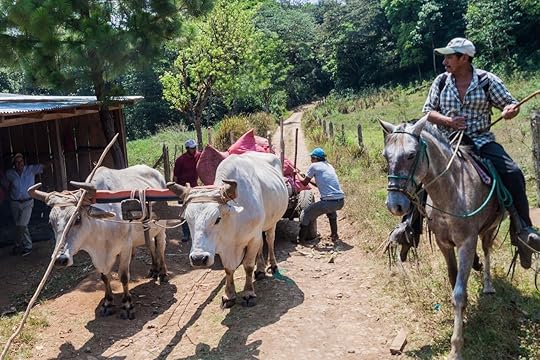
Photo: Matyas Rehak/Shutterstock
Despite this, the protests and ensuing travel advisories have crippled the country’s once thriving travel industry. But to my surprise, as I recently dragged myself towards the back of flight UA 1433 bound for Managua last May, I was met with a bit of familiarity. While most of the plane’s passengers were Nicaraguan, the last three rows were filled entirely with surfers. None of these back-row travelers preoccupied themselves with the State Department’s words of warning. They were more concerned with the incoming south swell that was bound for Central America.
Upon landing in Managua, I spent my first few hours taxiing around the Nicaraguan capital, stocking up on supplies for the remainder of my trip. Despite the concern expressed by friends and relatives, the city felt completely calm. There were no marches, no unruly crowds, and certainly no displays of violence.
Eventually, I made my way into the countryside toward La Barra Surf Resort in Miramar, Nicaragua. If the city was calm, then the countryside was beyond harmonious. Rolling green hills and farmland backed up to a dense tree line of the tropical jungle. Every so often, the car would slow as it passed a horse-drawn wagon carrying produce. If it weren’t for the fact that each wagon was propped up on Mitsubishi tires, I would have thought I’d traveled back in time.
The view from a local surf resort

Photo: La Barra Surf Resort Nicaragua/Facebook
When I arrived at La Barra Surf Resort, I half expected to find an empty hotel. Perhaps if I’d come six months earlier, I would have. However, upon arriving at La Barra, I was greeted by a crowd of fellow surfers from all over California who were just returning from a sunset surf. I hurriedly put my things in my room and joined them on the back porch to get my first glimpse of the waves over a few beers.
La Barra Surf Resort sits perched atop a 30-foot cliff, overlooking the vast Pacific Ocean. A staircase off the back porch descends the cliff face to access four different surf breaks, each of which I became intimately familiar with during my stay. While most mornings and afternoons were spent in the water at one of those surf spots, or boat-tripping to other waves, the back porch was also a dominant feature in my trip. Pre-surf coffee, post-surf beers, and everything in between happened on that porch.
During those long stretches of time on the porch, conversations ranged from surfboard design to profound, existential questions — but, every so often, politics came up. More often than not, Alonzo Vargas, the manager, or one of the local staff members would participate and offer their opinions on the state of things in Nicaragua, shedding light on some of the information I had only read about previously.
Throughout those conversations, I was made aware of the enormous impact the 2018 political strife had on Nicaragua’s travel industry. I heard that a vast number of businesses were forced to shut their doors as a result of the dive in travelers to the area. I learned how the protests affected the staff personally. For those at La Barra Surf Resort and the surrounding businesses in the area, the protests came as a surprise, and no one was prepared for the damage that would follow.
Surfers keep on coming

Photo: LMspencer/Shutterstock
2018 had been shaping up to be one of the best years on record for Nicaraguan tourism. New businesses were popping up all over. The tiny fishing village of Miramar, where La Barra is located, even had a bar open up, where locals and tourists alike could gather at the end of the day and tell stories until the odd hours of the morning.
Peculiarly, while businesses like the local bar, hostels, and hotels in nearby León — as well as luxury resorts — were forced to close temporarily, lay off workers, or even shutter permanently, the surf camps were able to weather the storm. Alonzo told me that immediately following the protests, La Barra had a wave of cancellations, but during the actual protests in the summer months, they had been almost full. None of their guests felt the need to cancel or leave early once there.
The fact that the protests and roadblocks were concentrated in urban areas meant that guests at La Barra and other surf destinations were virtually unaffected. Despite this, their hearts still ached for those suffering in Managua and other cities.
They also saw a sudden shift in the demographic at their property. While La Barra obviously caters to surfers, they also host backpackers, non-surfers, family travelers, and tourists from all walks of life. Since the protests, their business has evolved into a steady stream of surfers who are in Nicaragua for one thing only: waves.
But other travelers have yet to return

Photo: Marc Venema/Shutterstock
Some nights, after surfing until near dark, we would rush into León for a change of scenery and a bit of nightlife. León had been a backpacker’s hot spot before the events of 2018. The streets of León had always seemed lively, and the Spanish colonial architecture is some of the oldest on the continent. Roughly $3 will cover entrance to the León Cathedral, which is older than the United States. During our ascent to the cathedral roof, I was shocked to find the place nearly empty. In years past, it had always been packed.
From the domed roof, we watched a thunderstorm roll in from the distance. As the clouds moved in from the nearby volcanic peaks, we decided to move to a small restaurant in the main town square. Over Micheladas, we watched the rain come and go, and we marveled at the city’s beauty at night.
Following the protests, León saw a sharp drop in visitors. During the protests, León was one of the sites of conflict. While walking the streets of the city late at night, however, the scene appeared identical to when I was there a mere few years earlier, albeit with far fewer foreign faces.
Surfers are keeping tourism alive

Photo: Francisco Blanco/Shutterstock
To discover if this drop in tourism affected the rural areas of the country, I called my good friend Jonathan Griffin, owner of Thunderbomb Surf Camp, which is located in the far northwest corner of Nicaragua. Its proximity to the heavy beach break, The Boom, attracts surfers from all over the world. And when I asked Jonathan if surfers were still showing up, despite the recent political strife, he sang a similar tune to Alonzo.
“Listen,” Jonathan told me. “Surfers have been traveling to Mexico and El Salvador for decades, despite what they read online or see on the news. So, we’ve been lucky.”
By lucky, Jonathan means that they have been able to appeal to hardcore surfers and maintain a steady stream of clientele throughout the turbulent times. Hotels and surf camps that service families or the yoga and wellness crowds have greatly suffered. Surfers have always thrown caution to the wind when it comes to traveling. For many of us, the allure of near-perfect waves is worth the assumption of certain risks — real or apparent.
“It is important to note that our beaches have never stopped receiving surfers, not even during the crisis of last year, and they never had any incidents regarding safety or security in [the] country,” officials at the Tourism Board told me.
Germán Sanchez, owner of The Boom Hostel and Nicaraguan native, witnessed firsthand the impact of the protests on local businesses. Like most hotels and hostels in the region, business slowed significantly for The Boom Hostel. They nearly lost all business from backpackers and non-surf travelers. But surfers kept them afloat.
It’s time for other travelers to return

Photo: Anna Jedynak/Shutterstock
Business owners like Germán and officials at the Nicaragua Tourism Board illuminated for me how the country is recovering from last year’s events while maintaining hope for the future. They labeled this recovery period as “a stage of understanding and reconciliation” in which the protests stopped, and the country returned to its path of progress and peace.
When speaking on the recent slight increase in tourism in Nicaragua, Germán expressed a sentiment I imagine many Nicaraguan business owners feel: “I want people to come back to Nicaragua. Not for me or The Boom Hostel, but for everyone down here. It has been hard for people. They need their jobs back.”
When discussing their hopes for the country’s future, Alonzo, his surf guide, the La Barra cook staff, the waiters in León, Germán, and Jonathan all had the same response: a return to peace and normalcy. With an election coming up in 2021, Nicaraguans desire real change.
In the meantime, they wish that other travelers will follow in the footsteps of surfers and support their economy after so much hardship. 

More like this: After falling from the brink of a tourism boom, Nicaragua is ready to welcome the world back
The post After the protests, surfers are saving Nicaraguan tourism appeared first on Matador Network.

Get paid to eat and drink in Croatia

Here’s a question that is guaranteed to get a yes from even the most dedicated homebodies: Do you want to travel around Croatia, drinking wine and eating at restaurants for free? Follow up: Would you also be interested in being paid to do it? No, this is not a too-good-to-be-true practical joke; it is a very real job listing.
Recently, the travel company Croatia Cruise posted a lengthy job description for a “keen food and wine enthusiast” to take part in a seven-day adventure down the coast of Croatia. The Food and Wine cruise takes place in October 2020, and the company needs a “connoisseur” of the finer things in life to taste test the excursion’s offerings and then provide feedback to the company.
There are likely many people out there who’d take the trip for free (after all, you’ll be well fed along the way), but Croatia Cruise is offering a flat fee of £500 (about $600), and, of course, your accommodations onboard will be covered.
The trip follows a pre-planned route, starting out in the “medieval city of Split,” before moving on to “the ancient walled city of Dubrovnik,” where you’ll enjoy guided tours and a chance to experience Krka Waterfalls National Park. After that, you’ll move down the coast, passing through the Dalmatian islands.
Croatia is currently home to 800 wineries, which might tempt any wine lovers looking for a (literal) paid vacation. A wine expert will be on hand aboard the ship to provide “wine lectures” to expand your knowledge. And about that food: The ship itself promises breakfast every morning and decadent four-course lunches, in addition to the restaurants you’ll be stopping at along the way.
Of course, Croatia Cruise isn’t looking for just anybody. You should have just a little bit of wine knowledge already, as they’re looking for someone who “knows their cabernet from their chardonnay.” And picky eaters can forget about it. You should be brave enough to try any dish that’s set in front of you.
No resume needed to apply. Simply fill out the form on the website, along with a short essay explaining why you deserve to travel around Croatia drinking wine for free. We could all use such a splendid vacation, but if you want Cruise Croatia to sponsor you, you better have a better reason than “I’m sick of my office job.” 

More like this: Everything you need to know before going to Yacht Week in Croatia
The post Get paid to eat and drink your way along the Croatian coast appeared first on Matador Network.

Hand sculpture in Wellington
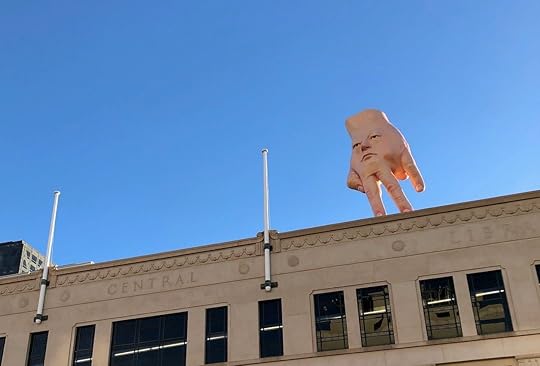
A dystopian sculpture is looming over Wellington, New Zealand, casting an ominous shadow. On Monday, a giant hand with a face was installed on top of Wellington’s City Gallery, carried in by a helicopter. Created in 2016 by Ronnie van Hout, the artwork was originally located on top of the Christchurch Art Gallery. Now, it’s on loan to Wellington (definitely not because Christchurch was trying to get rid of it). The sculpture is 16 feet high, weighs a whopping 880 pounds, and the relocation operation cost $47,000.
The sculpture is named “Quasi” after Quasimodo from Victor Hugo’s The Hunchback of Notre Dame. According to van Hout, it was named after Quasimodo because “it’s a human form that’s not quite human as well. The idea of something that resembles a human but is not quite human.”
Unsurprisingly, people have mixed opinions about the giant hand. Users on social are saying the sculpture bears an uncanny resemblance to Donald Trump and Thing from The Addams Family. Some observers claim that the hand is disturbing and makes them deeply uncomfortable. One Facebook user wrote, “So glad it’s gone from Christchurch!” Another wrote, “Big ups to the artist for creating something unique and having it on public display but this hand is the stuff of nightmares.”
Others, however, are more positive. “I love it, personally,” said one hand admirer on Facebook. “The people who hate it are incredibly boring.”
For some reason, this feels like just the beginning of the hand controversy. 

More like this: The 9 best street art cities in the world
The post New creepy hand sculpture watches over Wellington, New Zealand appeared first on Matador Network.

New suites on the Orient Express
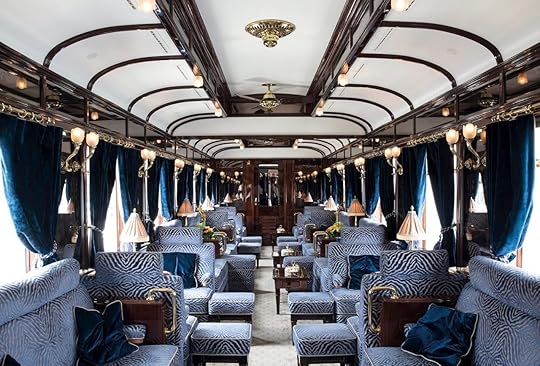
You probably don’t want to actually get caught up in a murder on the Orient Express, but simply riding on the storied train is exciting enough. The Venice Simplon-Orient-Express train transports you back to the early 20th century, and now there are three new grand suites to further add to the ride’s immersion. Named after Vienna, Prague, and Budapest, all of which are on the train’s route, the suites will be styled in their respective city’s aesthetic, inspired by its unique features.
Gary Franklin, Belmond’s Trains and Cruises Vice President, said in a statement, “Each meticulous suite will draw inspiration from the romance, adventure and style of each great European city we travel to. The suites evoke the individual city experience whether it is walking along the Charles Bridge in Prague or exploring the contrasting Gothic and Ottoman architecture of Budapest.”

Photo: Belmond
The train’s other existing suites — like Paris, Istanbul, and Venice — are also named after the cities they represent, all of which serve as stops on the route. To check out the new additions, the train runs from March to November, but it only makes the full trip from Paris to Istanbul once a year. And, as you probably expected, the grand suites aren’t cheap. They start at $7,500 per person. 

More like this: The 11 most beautiful train stations around the world
The post The Orient Express is getting three new grand suites inspired by Europe’s iconic cities appeared first on Matador Network.

The best coconut desserts
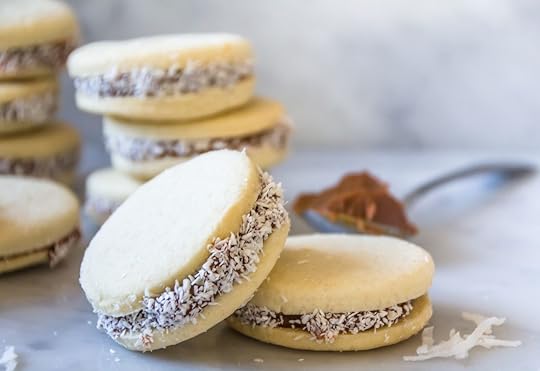
Whether it is shredded, turned to custard or jelly, whipped into ice cream, or sprinkled onto a cookie, coconut holds a revered status in the realm of dessert. Nowhere is that more true than in Latin America and Southeast Asia.
Coconuts thrive in the tropical climes of Southeast Asia. They’ve been a life-saving source of sustenance in that part of the world for centuries, but it’s a beloved dessert, too. In Malaysia the coconut tree is called the “tree of a thousand uses.” In the Philippines, it’s known as the “tree of life.” Coconut cream is used to flavor sweet beverages layered with crushed ice (perfect for the region’s sweltering heat) in layered jellies, and ice cream. Pandan, an aromatic leafy green plant, is often pounded into a paste to add neon green hues and extra sweetness to coconut desserts. Meanwhile, in Latin America, coconuts are as common as clouds in the sky. Shredded coconut flavors cakes and is turned into candy and custard.
These are 15 coconut desserts worth trying as you travel the world.
1. Kanom tuay from Thailand

Photo: OhLanlaa/Shutterstock
A popular street food in Bangkok, kanom tuay is a double-layered coconut milk custard. The bottom layer is made with palm sugar and sometimes flavored with pandan. It’s sweet and sticky, almost like a jelly or an eggless, custard-like flan. The top layer is creamy with a salty coconut flavor. Kanom tuay is always served in a small ceramic dish (tuay means cup). In Thailand, kanom tuay is often enjoyed after eating a hearty bowl of noodles.
2. Buko pandan from the Philippines
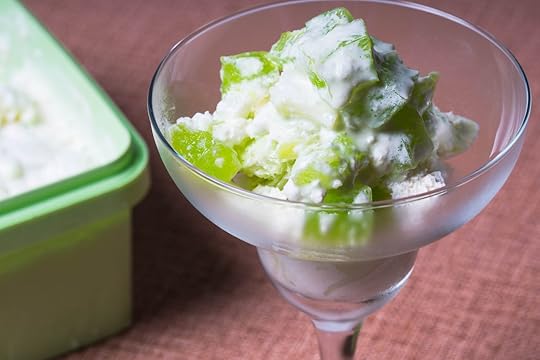
Photo: richardernestyap/Shutterstock
This classic dessert from the Philippines is a sweet salad. Green pandan jelly cubes float in a mixture of shredded coconut, tropical fruit, and sweet coconut cream or sweetened condensed milk (buko means coconut in Tagalog). Buko pandan is typically served during a Filippino salu-salo, a dinner party or gathering among friends, and is especially popular around Christmas. Buko pandan is a version of samalamig, which are sweet beverages featuring jelly ingredients.
3. Alfajores from Argentina, Chile, Uruguay, Colombia, Peru, Bolivia
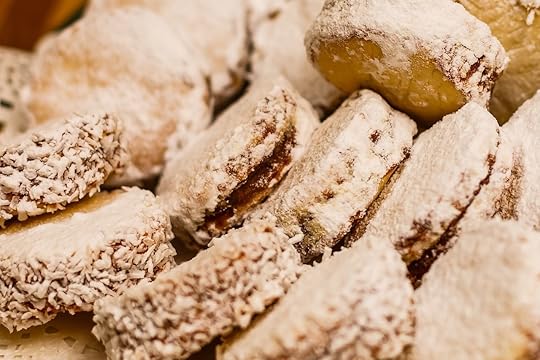
Photo: Andrew Angelov/Shutterstock
These butter cookies are popular throughout South America and are both made at home and sold in supermarkets. Two cookies sandwich a layer of creamy dulce de leche filling, which is then topped with powdered sugar and rolled in coconut or dipped in chocolate. The name for this cookie probably comes from the Arabic word al-hasú, which means “filled.” In 711, the group then known as the Moors (North African Muslims) occupied Spain, bringing the maamoul, a cookie filled with date paste, to the Iberian Peninsula. The Spanish adapted the recipe, adding honey and almonds. When Spain began its own campaign of colonization, the Spanish introduced South America to the alfajor, where it again evolved to incorporate dulce de leche.
4. Helados de paila from Ecuador
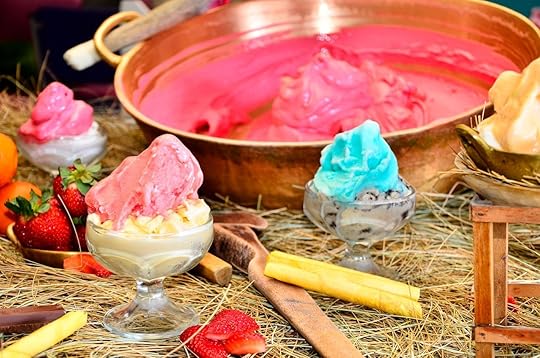
Photo: robert gibson z/Shutterstock
This sorbet-style frozen treat is made from fruit, ice, and water. It’s made in the paila, a shallow, wide metal pan used to cook throughout South America. The process involves several steps: First, salt and ice must be packed around the paila to keep it cold. Then, fruit blended with a touch of sugar is poured into the paila itself. Then comes the arduous process of combining the ingredients with a wooden spatula or spoon until the mixture is thick, smooth, and creamy. One of the most popular flavors is coconut.
According to local legend, helados de paila originated in Ibarra in northern Ecuador. At a time when refrigerators weren’t yet common, helados de paila could supposedly only be made when it hailed.
5. Kyauk kyaw from Myanmar
This square coconut jelly dessert uses agar agar (a colorless, tasteless jelly-like substance extracted from red algae that’s popular throughout Asia as a gelatin substitute) rather than gelatin to achieve its signature texture. As the jelly sets, it separates into two elegant layers, one opaque coconut layer on the top, and on the bottom a transparent water layer. The coconut flavor is mild and refreshing, reminiscent of coconut water in solid form.
6. Es teler from Indonesia
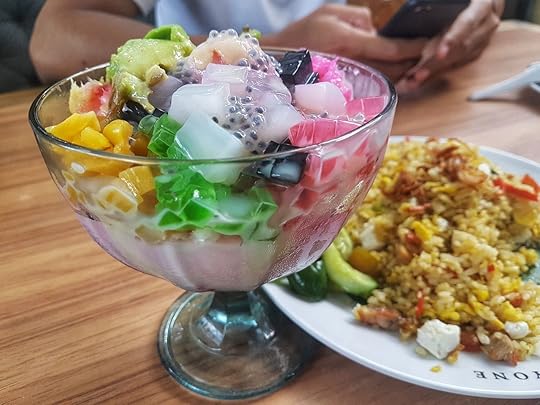
Photo: prasetyobie/Shutterstock
This Indonesian fruit cocktail could also be considered a beverage. The refreshing concoction combines chopped jackfruit, coconut meat (not shredded, dried coconut), and avocado in a dish filled with ice, coconut milk, and sweetened condensed milk. According to one story, es teler originated in Jakarta, where the idea for the drink came to its creator in a dream. It’s considered Indonesia’s national beverage.
7. Chè bắp from Vietnam

Photo: Shatchaya/Shutterstock
Chè bắp is a sweet corn pudding. Sweet corn is combined with tapioca pearls to thicken the pudding and add a chewy texture, and it’s then cooked in creamy coconut milk. Some varieties of chè (the general term for Vietnamese sweet beverages or puddings) also incorporate fruit like jackfruit and durian, or ingredients like mung beans, pandan, or sesame seeds. Though chè bắp is easy to make at home, it’s often sold in plastic cups at Vietnamese grocery stores.
8. Itim kati from Thailand

Photo: TarantulaToom/Shutterstock
This Thai coconut ice cream is sold from roving street vendors throughout the country. It’s served inside half a coconut, and you’ll hear the vendors coming from the sound of the tinkling bell attached to the car). Itim kati can be customized with toppings. The most popular options include peanuts, sliced mango, and sticky rice, which adds a slightly savory note. Some street vendors even sell creamy coconut ice cream between slices of bread.
9. Lod chong from Thailand
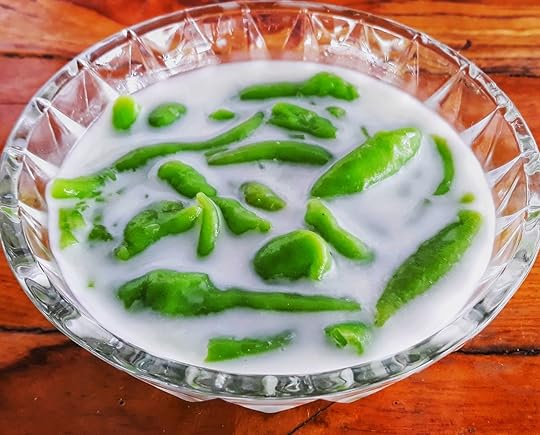
Photo: Punnada Phurirattanakul/Shutterstock
Pandan imparts the noodles in lod chong with an electric green color. The name of this dessert comes from the process by which its made. Lod chong translates to “escaping through the holes.” The liquid custard — made from rice flour, mung bean flour, and water — is pushed through small holes to create the long noodles, similar to spaghetti. The noodles have no taste and simply add a jelly texture. The noodles swim in a sweet syrup made from coconut cream and palm sugar poured over ice.
Lod chong is often served after a spicy meal. The dessert can also be found at street vendors, which will sometimes serve the coconut syrup and noodles and crushed ice in separate plastic bags, requiring the customers to combine the ingredients themselves. Versions of lod chong, often called cendol, are popular in Indonesia, Vietnam, and Cambodia.
10. Bien me sabe from Venezuela
Similar to a tres leches cake, bien me sabe (“tastes good to me”) is also known as coconut cream cake. The moist, yellow cake is made with layers of coconut cream, a meringue topping, and has a sprinkling of dried, shredded coconut. Ladyfingers are also often used instead of yellow cake. It should be chilled overnight to give the coconut custard a chance to set. A version flavored with almonds is popular in the Canary Islands. The cake is likely an import from Spain; in Andalusia you can still find a variety made by nuns.
11. Tembleque from Puerto Rico
This rice pudding flavored with coconut milk and spices like nutmeg and cloves is one of the most popular desserts in Puerto Rico. Traditionally, tembleque is served during the holidays, in particular on New Year’s Day and Christmas. The word tembleque refers to an object that jiggles, hence this jelly or custard-like dessert’s name.
12. Queijadinha from Brazil
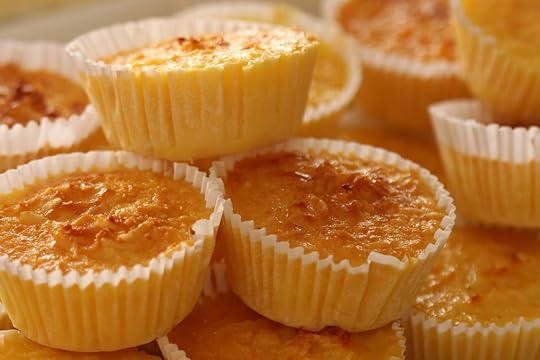
Photo: Horus2017/Shutterstock
These so-called “coconut muffins” originated in Portugal but are now most popular in Brazil. Once the treat took root in Brazil, slaves likely added coconut to the recipe. Though the outside of the queijadinha is firm, the inside has a looser, pudding-like texture from the parmesan cheese, coconut, and condensed milk filling. The dessert is especially popular in the Northern region of Brazil.
13. Khanom chan from Thailand
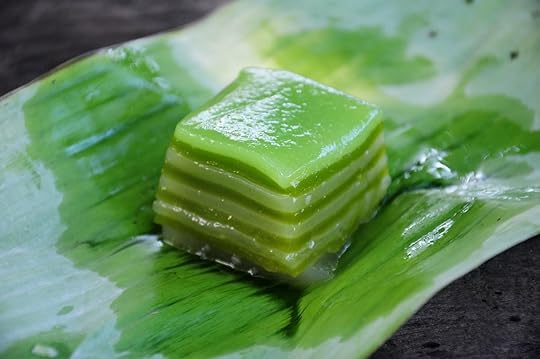
Photo: Tarn Tiny/Shutterstock
This Thai cake has nine layers, as the number signifies luck, prosperity, and progress in Thailand. It’s often served at weddings, birthdays, graduations, and other auspicious occasions. The cake has the consistency of jelly, but coconut cream and coconut milk give it a silky, creamy texture. The signature of khanom chan has even led some to nickname it Thai jello. The mild flavor makes this little coconut and pandan square the perfect palate cleanser after a spicy meal.
14. Coconut burfi from India
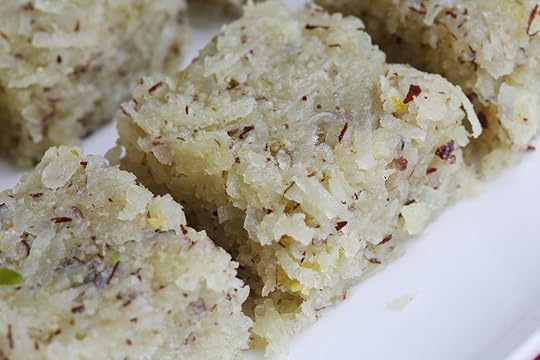
Photo: SMDSS/Shutterstock
These bite-sized coconut rectangles are a popular dessert in India and have a texture similar to fudge. Instead of chocolate, however, coconut burfi is made with milk and sugar, then flavored with cardamom. The texture shouldn’t be sticky but more like a firm, chewy cookie. Coconut burfi is a popular treat to serve at celebrations like Diwali. On such special occasions, burfi is often topped with edible silver leaf. The name for this dessert might derive from the Persian word barf, which means “snow,” due to the fact that the primary ingredient is shredded coconut.
15. Dulce de coco from Colombia and Cuba
This simple dessert, also known as coconut candy in Cuba, consists of shredded coconut soaked in coconut syrup. The grated coconut is cooked in milk and sugar until a sticky, gooey mass of coconut forms. It can easily be eaten with a spoon, but it is also often separated into smaller, individual bite-sized pieces or rolled into balls. In Cuba, it’s served alongside cheese, cookies, and bread. 

More like this: Why Southeast Asia’s best desserts are bright green
The post The 15 best coconut desserts served around the world appeared first on Matador Network.

Hike the Jefferson Pass Traverse

With nearly three million annual visitors, Glacier National Park is the 10th most-visited national park in the country. Yet, very few of these visitors leave the roadways, campgrounds, and hotels that are easy to access and, when the rain comes in, easy to leave. Covering over a thousand acres of pristine Rocky Mountain wilderness, this park in the northwest corner of Montana just south of the border with Canada is a diverse ecosystem with hundreds of lakes, hundreds of animal species, and thousands of plants. The park’s iconic ridgelines and 25 active glaciers are stark and foreboding, not to mention the large mammals like grizzlies, moose, mountain goats, wolverines, and lynxes that roam the interior. The Jefferson Pass Traverse is the ultimate way to break from the usual park routine and experience this wilderness. Here’s how to hike and camp the traverse.
Advance preparation for the trek

Photo: Pung/Shutterstock
If you’re looking to get away from crowds in any national park, the answer is to head off the main roads and the heavily photographed sites you see in gift shop brochures. Find the adjacent trails that lead into the backcountry, of which Glacier offers hundreds of miles leading to dozens of designated and non-designated campsites that are well kept and stunningly beautiful to stay at. Ninety-three percent of the park is managed as a wilderness, though it doesn’t have the full designation, which is relatively uncommon. In order to camp on this trek, you’ll need a “non-designated sites” camping permit from the National Park Service. Obtain this at the on-site permit office and expect to pay $7 per night.
The legal grey area surrounding the wilderness designation allows for some unique trips, including the Jefferson Pass Traverse. Jefferson Pass itself is just south of the Canadian border in the north of the park. You’ll camp in non-designated campsites along the way. If you’re in search of real solitude and true adventure, the Jefferson Pass Traverse might be right up your alley.
Planning and routing your hike over the Traverse
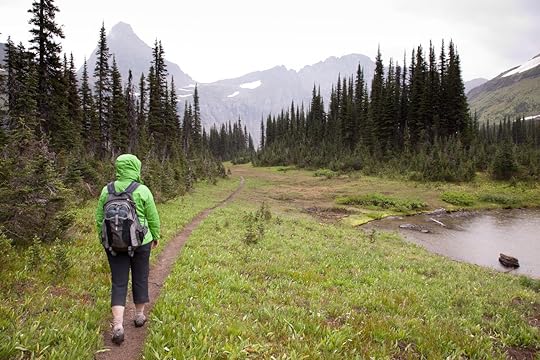
Photo: Jim David/Shutterstock
From start to finish, the trip takes four days, with three nights of camping along the way. You’ll cover roughly 45 miles, much of which is off-trail but easily navigable with proper planning and equipment. The best window for hiking the Jefferson Pass Traverse is late July, August, or early September, after the snowpack has melted out of the more technical gullies. Other considerations include weather, bears (Glacier occasionally shuts down trails and routes due to aggressive activity), bugs, and rutting season, during which moose and elk are more territorial. But barring extenuating circumstances, a trip planned during this time should leave the terrain in passable condition.
Because of its off-trail sections, your primary resource for routing the trip is the book Climbers Guide to Glacier National Park by Gordon Edwards, a title that Glacier rangers unironically call “the bible.” This bestseller offers maps and important info on how to find and access the most challenging and hidden cruxes in the route. With the book, you can find your way from the point where you leave the Old McDonald Creek Trail until you exit on the other side of the traverse. The routes closely follow the northernmost reach of the Continental Divide in the US, along steep ridgelines and small goat trails. Another handy resource is CalTopo, which allows you to download topographic maps of the area and mark your specific route.

Photo: Arlene Waller/Shutterstock
Jefferson Pass is a point-to-point route that begins at The Loop on the iconic Going-To-The-Sun Road. The first few miles are on the Granite Park Trail, which starts uphill to meet up with the Highline Trail. When the Highline intersects the Waterton Valley Trail, the route heads west, descending into a dense valley and loosely following the old McDonald Creek Trail. The next three days are all off-trail, and navigation and route finding skills are critical. A very small goat trail provides access to the ridge past Thunderbird Peak, to Thunderbird Glacier, and back to the trail on Brown Pass. From there, the hike is roughly 10 miles on Bowman Lake Trail to the ranger station and campground at the west end of the lake. There are ample camping options along the way, arguably some of the prettiest places in the park and free from the hordes of RV-driving tourists back on the main routes.
The majority of the traverse is above treeline, only occasionally dipping into valleys along the way. You’ll have to bushwack a bit, the most challenging of which is the first — fighting through an old burn with a thick understory, the route heads west from the trail up Trapper Peak. From there, you head to West Flattop Mountain towards Vulture Peak and summit Nahsukin Mountain. Then, carefully walk northwest along the alpine ledge to Redhorn Peak and down to the namesake Jefferson Pass. From this lookout, there’s a clear view of the next five miles, and at this point the scree slopes get steep, traversing past a peak called The Guardhouse to Sentinel Mountain, which is often full of snow and quite steep.
What to pack for the trip
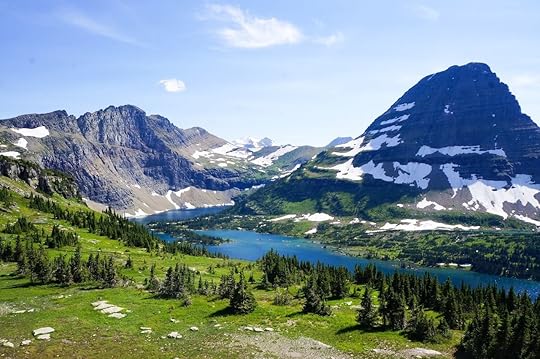
Photo: Kelsey Thomas/Shutterstock
Hiking off-trail requires all of the key backpacking gear necessary for any multi-day jaunt into the wilderness, including good sleeping bags, tents, stoves, a water filter, food, first-aid supplies, navigation equipment including a routed map and a compass, and a headlamp. The unique and necessary gear for the Jefferson Pass Traverse includes basic trail crampons, an ice axe, hiking poles, stiff boots with high ankles, and a few extra snacks (I prefer Apple-O’s) that can turn the mood in a pinch.
I try to pack light, limiting myself to a 50L pack at most. To do this, versatility in layers and gear is key, particularly because you still must prepare for any storms in the forecast. I packed my three-season Trango tent and Phantom Alpine sleeping bag, both from Mountain Hardwear. I’ve trusted these to keep me dry and warm on month-long backcountry trips, so I knew they’d work for this shorter excursion. Packing everything in dry bags, I also brought my thicker Gore-tex shell, in case the winds and rain took a turn for the worse. With our group of five, I opted for a 2.5L Windburner Group Stove System and 10L Gravity Filter, both made by MSR, making water fill-ups and food preparation much faster. Because Glacier is home to many bears and pesky rodents, it’s also required to bring a bear barrel for storing food, bear spray in case of a close encounter, and it’s always worthwhile to bring some bug spray for your own sanity’s sake.
Hiking off-trail on mellow and open alpine meadows is pretty easy, but don’t expect that for most of this traverse. Glacier is true wilderness and if you come in without the right preparation, things will likely go wrong. With the advancement of GPS and app-based mapping, phones have nearly replaced their paper predecessor but shouldn’t be the only navigation resource you bring along. The ability to read topo maps is something I can’t stress enough. The same goes with your ability to negotiate weather systems, proactively prevent dangerous animal encounters, manage food, some training in first aid and, importantly, your ability to find safe routes in challenging terrain. These are all surefire prerequisites to make the Jefferson Pass Traverse a fun and safe adventure. 

More like this: Why you need to hike the Wind River Range in Wyoming
The post How to hike the Jefferson Pass Traverse in Glacier National Park appeared first on Matador Network.

Where to drink in the Hudson Valley
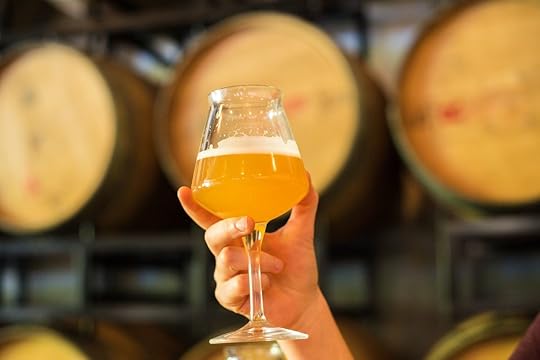
If the history of colonial New York teaches us one thing about our forefathers and mothers, it’s that they loved a good drink. Thanks to the state’s hops- and barley-friendly climate, the country’s first commercial brewery opened in Manhattan in 1632. Distilleries, run mostly by farmers, soon followed. Around the early 1900s, the state had about 1,200 distilleries and some 400 breweries.
As the noble experiment of Prohibition began in 1920, alcohol production quickly scurried underground — and into bathtubs and backyard sheds. Within five years, New York City had 100,000 speakeasies and nightclubs, most protected by gangsters, with dozens more along the Hudson River, which served as a conduit for bootlegged spirits from Canada. From road to rail and river, the region was infamous for its enterprising smugglers. One inspired team was even suspected of sneaking their illicit cargo upriver via submarine.
“People never really stopped drinking; they just kept it a secret,” explains Emmanuel Treski, the bar manager of Speakeasy 518 in Albany.
Prohibition may have ended in 1933, but high taxes and bureaucracy kept small distillers from making spirits in New York for nearly 70 years. When distilling finally came back to the state, it started in the Hudson Valley.
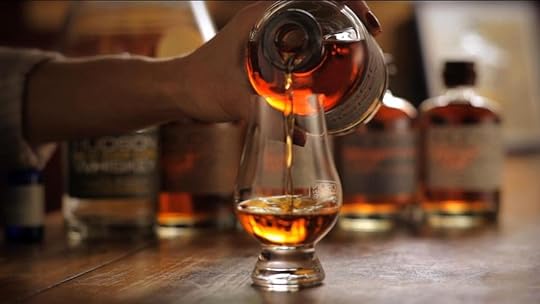
Photo: Tuthilltown Spirits/Facebook
New York’s modern spirits industry can be traced back to a gristmill in Gardiner, a town of less than 1,000 people in Ulster County that has rolling hills carpeted in thick blades of grass and trees that drop a harvest-hued rainbow of leaves in the fall. Ralph Erenzo bought the property (including the gristmill) in 2001. Residents blocked his plans for a campground, and a legal fight ensued. Eventually, a local zoning officer told him about a new state initiative that lowered the previously exorbitant fees for distilling. The law allowed microdistillers that make less than 35,000 gallons a year to pay $1,500 for a distilling permit rather than the $65,000 larger operations must pay.
An industry novice, Erenzo spent the winter learning from farm-based operations in Europe. “I felt pretty confident this same form could work in the United States,” he says, “especially with the trend toward craft goods.”
In 2005, Erenzo and his business partner, Brian Lee, founded Tuthilltown Spirits, the first legal distillery in New York since Prohibition. Erenzo sold their first products, literally out of the trunk of his car, up and down the Hudson Valley.

Photo: Tuthilltown Spirits/Facebook
He didn’t stop there. Erenzo was one of the driving forces behind the 2007 Farm Distillery Act, which incentivized distillers to use New York-grown grains. Thanks in part to Erenzo’s push to bring distilling back to the state, there are now more than 100 distilleries in New York — the second most in the country after California.
Progress isn’t limited to spirits. In 2012 and 2013, Governor Andrew Cuomo passed the Farm Brewing and Farm Cidery laws, which overhauled antiquated alcohol control laws, reduced licensing fees and taxes, slashed the waiting time for license approval in half, and created a grant program for craft-beverage marketing.
Alejandro del Peral founded Nine Pin Cider in Albany in 2013 after experimenting on his own and working as an apprentice cider maker in Vermont. He calls New York’s legislation “incredibly progressive.” He notes that the benefits aren’t just for beverage producers, but also for farmers, thanks to the requirement in the farm bill laws that at least 75 percent of produce must be grown in the state.
“In the Hudson Valley, we have some of the best agricultural land there is,” del Peral says. “Rural areas like ours were embracing farm-to-table before people in the city knew it was a thing. We should be known for our farm-based products.”
Since 2012, more than 1,000 craft beverage makers have set up shop in New York. The Hudson Valley has proven to be a hotbed of creation, with 93 businesses making beer, cider, wine, or spirits opening between 2012 and 2018. The region is both the fastest growing and has the most breweries in the state, with more than 50 in the mid-Hudson Valley alone.
These range from Keegan Ales in Kingston, maker of Mother’s Milk, a New York Times top-ten North American stout to Galway Rock Vineyard & Winery in Ballston Lake, which crafts small-batch red, white, rosé, and sparkling wines from 100 percent New York–grown grapes. Some of the breweries have become world-class destinations for beer lovers, like Hudson Valley Brewery and Suarez Family Brewery. Tuthilltown is far from the only distiller now, too, with the addition of places like Olde York Farm in Claverack, which makes spirits flavored with local produce like rhubarb and ramps.
One of the reasons the laws have been so successful is because they granted the right to open tasting rooms. “Suddenly, we weren’t just in the distillery business, we were in the tourism business,” Erenzo says. “That changed everything.”
The Visitor Center at Tuthilltown is rustic and comforting, with wide wood beams and weathered floors. It’s an easygoing place to enjoy a guided sampling of hand-crafted products like smooth, slightly sweet Hudson New York corn whiskey, earthy-spicy Half Moon Orchard gin, and butter-and-caramel-tinged cacao liqueur. A rotating menu of creative cocktails pays homage to the brand’s Hudson Valley roots.
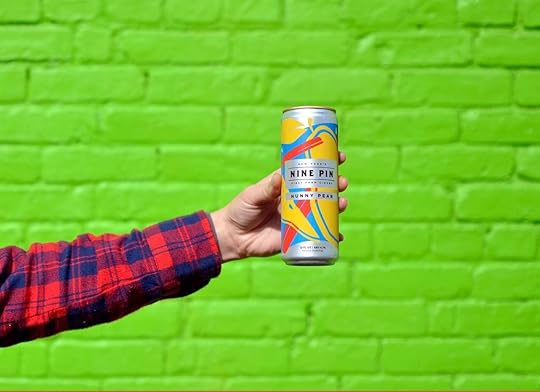
Photo: Nine Pin Cider/Facebook
A diversity of options and vibes came along with the rise of craft beverages. The Nine Pin tasting room, located in downtown Albany, has an urban vibe. The garage-door entrance reveals a renovated warehouse with tall ceilings, metal columns, and chunky wood tables where patrons can play board games and listen to live music. They can also sample nine ciders ranging from dry to ginger to a full-bodied rosé cider. Nine Pin offers original cocktails and several local beers, plus snacks like locally made cheese, pizza, and hand pies.
In addition to Nine Pin, del Peral co-founded the Capital Beverage Trail, one of six trails in upstate New York. Originally a four-stop tour, the trail currently has more than two dozen producers.
“There’s no better group of people to have as your peers,” del Peral says. “We all understand that our success is dependent on us working together. We know we have to establish our place in the landscape.”
Their place is now recognized by a growing number of people, who, much like those early colonial settlers, value a good craft beverage.
“Cocktail and brew culture has seen a huge resurgence,” Treski says. “A lot of people have an understanding and appreciation of the craft. They keep coming back because they know what’s produced here takes time, labor, and a lot of love.”
Where to drink in the Hudson Valley

Photo: Tuthilltown Spirits/Facebook
Tuthilltown Spirits: See where New York’s modern distilling movement started. The brand’s Hudson Baby Bourbon is perhaps the most popular, but there are plenty of other options to try like the rye, vodkas, gins, and liqueurs.
Where: 14 Grist Mill Ln, Gardiner, NY 12525
Nine Pin Cider Works: Games and live music complement the house-made ciders on tap in this Albany cidery that was New York’s first farm cidery. The ciders are made using apples sourced entirely from capital region and the Hudson Valley.
Where: 929 Broadway, Albany, NY 12207
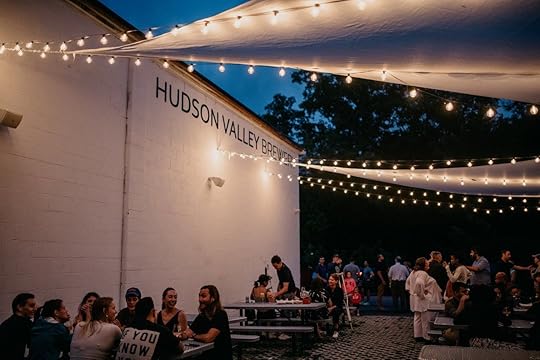
Photo: Hudson Valley Brewery/Facebook
Hudson Valley Brewery: Although it only opened in 2017, Hudson Valley Brewery quickly became a well respected addition to the region’s thriving beer scene — and the country’s. It has garnered national acclaim for its sours and IPAs.
Where: 7 Main St, Beacon, NY 12508
Suarez Family Brewery: A favorite for anyone who appreciates a good lager, Suarez Family Brewery has a tasting room open Friday through Sunday from 1:00 to 7:00 PM, and from 3:00 to 7:00 PM on Wednesdays.
Where: 2278 U.S. 9, Hudson, NY 12534
Keegan Ales: An award-winning brewery that’s been open since 2003. Take a tour to see what makes the beers so great, and make a day of it by sampling fresh brews and eating at the on-site restaurant.
Where: 20 St James St, Kingston, NY 12401
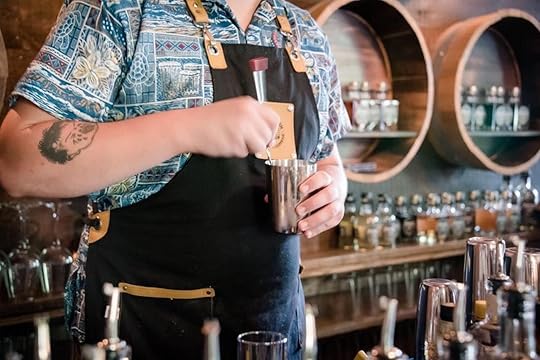
Photo: Olde York Farm: Distillery & Cooperage/Facebook
Olde York Farm: A woman-owned and family operated distillery that makes seasonal batch spirits using foraged and farmed ingredients from the Hudson Valley. It’s always worth checking out what’s new when nearby (or even better, staying at the Distillery Suite that’s listed on Airbnb).
Where: 284 NY-23, Claverack, NY 12513
Galway Rock Vineyard & Winery: Visit the tasting room and stroll past the vines at this Ballston Lake winery producing sparkling white, sparkling rosé, red, and white wines.
Where: 998 Saratoga Rd, Ballston Lake, NY 12019 

More like this: Rochester has reinvented itself as the Northeast’s best beer town
The post How the Hudson Valley became the best region in the US for craft beverages appeared first on Matador Network.

Matador Network's Blog
- Matador Network's profile
- 6 followers



